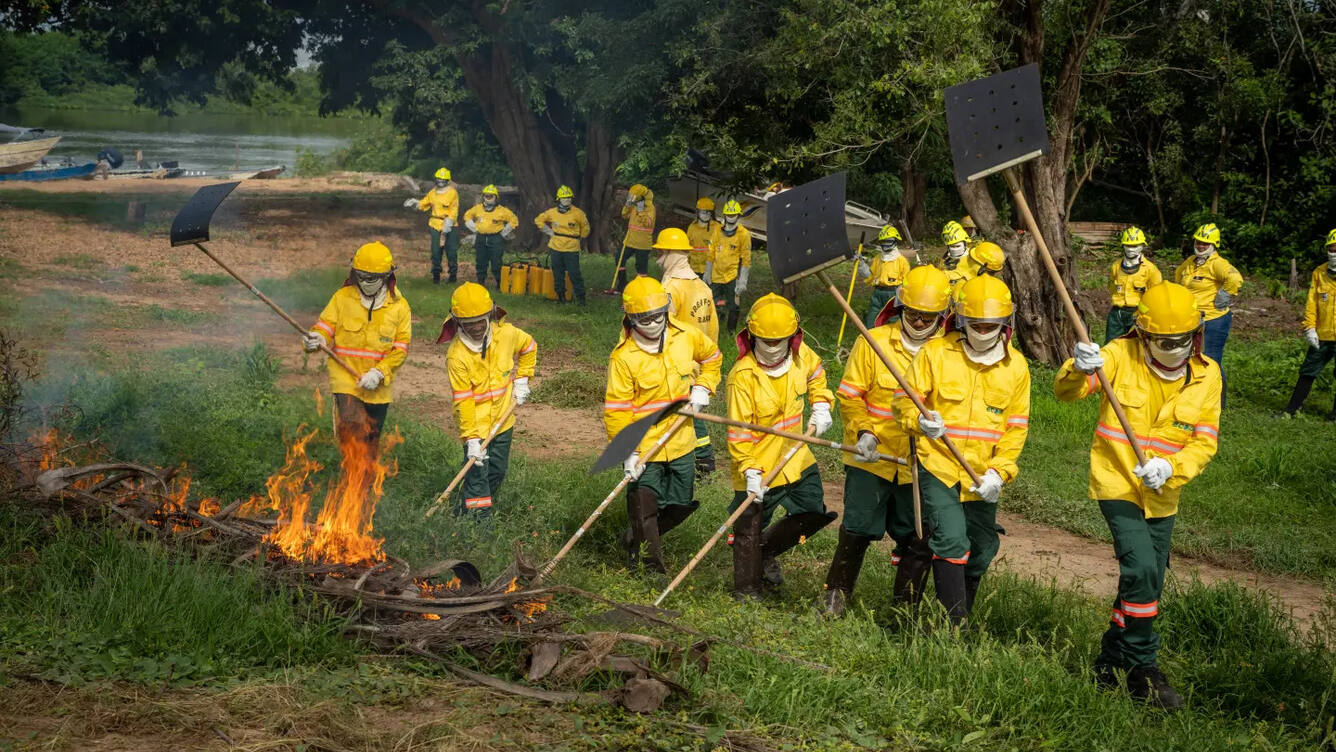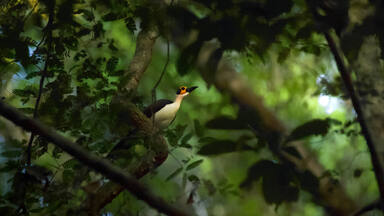UNESCO strengthens fire resilience in the Pantanal and Cerrado with support from local communities
The initiative aims to protect areas recognized as World Natural Heritage Sites and Biosphere Reserves through the Heritage Emergency Fund (HEF).
UNESCO is intensifying its efforts in Brazil to protect areas recognized as World Natural Heritage Sites and Biosphere Reserves in response to the rise in extreme wildfires driven by climate change. Through the Heritage Emergency Fund (HEF), the organization is leading a strategic initiative to bolster fire resilience in the Pantanal of Mato Grosso and in Goiás.
A total of 60 volunteers were trained through this project: 30 in the Pantanal Matogrossense National Park (MT), 15 in Chapada dos Veadeiros National Park (GO), and 15 in Emas National Park (GO). Around 800 pieces of equipment were distributed, including firefighting tools and Personal Protective Equipment (PPE). Additionally, an action plan is being developed to guide volunteer firefighters, based on Integrated Fire Management (IFM) and UNESCO’s Fire Risk Management Guide.
“The project funded by the Heritage Emergency Fund makes a significant contribution to local communities by recognizing and strengthening their vital role in fire prevention and control”
Interinstitutional initiative in the Pantanal
From 22 to 25 April 2025, the Serra do Amolar — a remote and hard-to-reach region between Corumbá (MS) and Cáceres (MT), on the border with Bolivia — hosted a community brigade training supported by UNESCO’s Heritage Emergency Fund. The activity took place in the Pantanal Matogrossense National Park, in collaboration with WWF-Brazil, GEF Terrestrial (Funbio), Ibama (PrevFogo), Ecoa (Ecology and Action), and the Brazilian Navy.
Three brigades, made up of 30 Pantanal residents — including 14 women — took part in the training. Over three intensive days of technical and practical lessons, participants learned fire prevention and control techniques from specialists.
In addition to traditional methods — such as the use of specific tools, fire front control, heat mapping, and surveillance — the training incorporated agroforestry practices adapted to the Pantanal context. “One innovation was the management of slash-and-burn plots and backyard gardens. These areas, besides being vital for local subsistence, serve as ecological corridors that can protect wildlife during fires”, explains André Luiz Siqueira, Director of Ecoa.
Another innovation was the introduction of the Sigma tool, a software developed by SOS Pantanal, which sends real-time fire alerts to mobile phones. Using satellite imagery and data such as wind direction and temperature, the technology is accessible even to those with limited formal education.
Support from the Brazilian Navy enabled the logistics for participants and specialists, including transport via small boats, 950 liters of petrol, and 870 kilograms of food. Accommodation was provided by staff from the Chico Mendes Institute for Biodiversity Conservation (ICMBio).
Geographical and climatic challenges in firefighting
Corumbá, covering over 64,000 km², is the 11th largest municipality in Brazil. The rugged terrain of the Serra do Amolar and limited access via rivers or air pose logistical challenges for firefighting. The presence of peat — organic matter accumulated in wetlands — creates highly flammable biomass during the dry season, making fires frequent and intense.
The region encompassing the Pantanal Matogrossense National Park is part of a UNESCO World Heritage Site alongside three Private Natural Heritage Reserves, and is also recognized as a Ramsar Site — an international designation for wetlands of high ecological importance.
“The Pantanal harbors great biodiversity and is vital for fish reproduction (ichthyofauna). This region is essential for traditional peoples, sustainable tourism, and the conservation of species such as the jaguar, giant otter, and giant anteater”
In 2024, the Pantanal experienced one of the worst wildfire seasons on record. According to the Laboratory for Environmental Satellite Applications (Lasa/UFRJ), around 2.6 million hectares — 17% of the biome — were consumed by fire. This was the second-highest figure since the historical series began in 2012, surpassed only by 2020, when 3.6 million hectares were devastated.
“The drought pattern has changed. Although climate change is intensifying, those combating the fires are now better organized. We have more brigade members, resources, support from the National Security Force, the Armed Forces, and a more structured state response,” says Márcio Yule, coordinator of PrevFogo/Ibama in Mato Grosso do Sul.
Extreme drought — worsened by the El Niño phenomenon — combined with improper fire use, high temperatures, and low humidity, has increased vegetation vulnerability and impacted biodiversity and traditional community livelihoods.
I’ve been a brigade member since 2001, and the training helps us in many ways. Having the right equipment, rather than just our bare hands, makes all the difference. As traditional people, we have knowledge of fire management and know the land. When firefighters arrive, they need to talk to the community to understand what’s happening here. This combination of our knowledge, training, and equipment allows us to care for the land and the Pantanal.
She is a quilombola and indigenous woman from the Guató people, living in the Barra de São Lourenço community — on the banks of the Cuiabá River near the Paraguay River, on the border between Mato Grosso do Sul and Mato Grosso, and the frontier with Bolivia.
Despite the increasingly challenging climate scenario, the combination of community mobilization, traditional knowledge, and technology has proven effective in mitigating damage. “The formation of civil brigades is more than a fire response plan — it is a territorial adaptation strategy that supports autonomy and resilience in the Pantanal,” says Osvaldo Barassi Gajardo, Conservation Specialist at WWF-Brazil.
With each new training session, more than just skills are developed — a living protection network is built, where nature, science, and community walk hand in hand. Brigade member Eliane has a dream for the world’s largest wetland. “We care for nature, and nature cares for us. My dream is a green Pantanal full of animals”.
Rosi do Céu, rooted in the Cerrado
Since childhood, 47-year-old Rosilene Rodrigues da Silva Santos has guided people through the beauties and unique features of the Cerrado biome in Chapadão do Céu, Goiás, Brazil.
"I grew up in this region. When visitors came to our house looking for tours, my parents would ask me to show them the trails, explain the routes, and teach them how to reach Emas National Park". Today, Rosi works as a guide at the park during weekend and holidays, volunteers as a firefighter, and has served as a primary school teacher for the past 28 years. Currently, she teaches first grade at a municipal school in Chapadão do Céu from Monday to Friday.
In 2010, a massive wildfire devastated approximately 90% of the 132,000 hectares of Emas National Park and the surrounding region. "That was my first time volunteering. The fire lasted several days, and the entire community helped. We brought clothes, supplies, and food for those battling the flames. It was my first experience with fire".
In her view, “nature still hasn’t fully recovered” from that fire. “The animals didn’t all return, there are far fewer now. But the Cerrado is life. It regenerates. The trees are twisted, with thick bark and deep roots. It’s on purpose. When fire comes, it doesn’t consume the forest floor. The Cerrado survives, it’s resilient,” she explains.
In April, Rosi participated in a fire brigade training coordinated by UNESCO, with support from the Heritage Emergency Fund (HEF), and with WWF-Brazil. Trainings were held at three sites: Chapada dos Veadeiros National Park (GO), Emas National Park (GO), and Pantanal Matogrossense National Park (MT) - addressing conservation efforts across the Cerrado and Pantanal biomes.
The training was excellent. Now we’re better prepared to manage the park during the dry season, following the management plan. And if emergencies arise, we know how to fight fires strategically, safely, and effectively.
But if you ask Rosi do Céu (Rosi of the Sky) what she loves most, the answer is nature and wildlife. “Some people admire celebrities. I admire those who love nature. I love the wilderness and care for animals”.
Rosi also makes handcrafted items from bamboo and wood, and rescues snakes and wild animals when needed. “Just send me a message on WhatsApp. If there’s an opossum or any creature, people say, Call Rosi, she’ll take care of it.” In 2018, she rescued a tapir and named her Preciosa (Precious). “Every time I go to Emas National Park, near where she stays, I call her name, she comes and eats from my hand. It’s love,” says the firefighter, guide, teacher, artisan, and animal caregiver.
Eliane: ancestral wisdom
Eliane Aires de Souza, 58 years, carries in her eyes and hands the wisdom born of deep interaction with nature and ancestral knowledge. A Pantanal native, she lives in the community of Barra de São Lourenço (MT), shaped by the waters and the vibrant life that surrounds her. She is an Indigenous woman of the Guató people, with quilombola ancestry, and works the land with knowledge and care as an agroforestry practitioner. Since 2001, she has served as a civilian firefighter, confronting the wildfires that each year are increasingly threatening the Pantanal.
This is our way of life. The Pantanal is our home. Having proper training and equipment helps us take care of it and protect our collective house.
Eliane is a mother, grandmother, and president of the Renascer Women’s Association, created to strengthen the dreams and autonomy of the women in her community. In her words, she highlights the daily challenges of keeping culture alive and staying connected to the land. “Here, we live off fishing, bait, and handicrafts”.
Eliane feels the effects of climate change and the abandonment of the rivers. She speaks with sadness of the Rio Velho, which no longer flows as it once did. “It’s like a clogged vein in the body. If we don’t take care of the river, the whole body falls ill”. For her, protecting nature means protecting herself, her family, her community, and the future. “That tree behind you is like a vein, it gives life to other lives”.
In her daily life, Eliane cultivates an agroforestry system at home. She nurtures and protects the land. “That’s what agroforestry is: we care for it, and it cares for us”. Drawing on ancestral wisdom, she explains the importance of nourishing the soil, preserving humidity, and ensuring shade, life, and food. She grows bananas, cassava, lemons, and oranges, and dreams of more. She envisions a seedling nursery and a green corridor that reconnects fragmented forest areas, providing food for animals and nourishing hope.
“If we keep waiting, the soil will die. And with it, our way of life”. She refuses to depend on the city for basic needs. “It’s the dream that keeps us going”.
And perhaps it is that persistent force of dreaming, that way of resisting with hands in the soil, body in the canoe, and soul in the crafts, that keeps the Pantanal alive. As long as there are Elianes and Rosis, there will be hope for rebirth.
About the UNESCO Heritage Emergency Fund
This activity was supported by the UNESCO Heritage Emergency Fund (HEF). We express our gratitude to its donors: the Principality of Andorra, the Qatar Fund for Development, Canada, the Slovak Republic, the Republic of Estonia, the French Republic, the Republic of Lithuania, the Grand Duchy of Luxembourg, the Principality of Monaco, the Kingdom of Norway, the Kingdom of the Netherlands, the Republic of Poland, the United Kingdom of Great Britain and Northern Ireland, the Republic of Serbia, and ANA Holdings INC.

